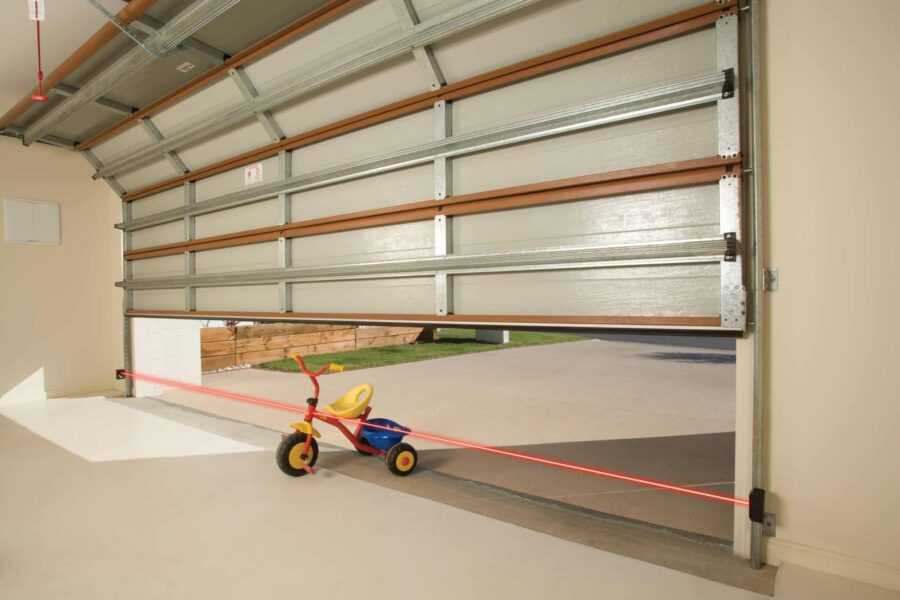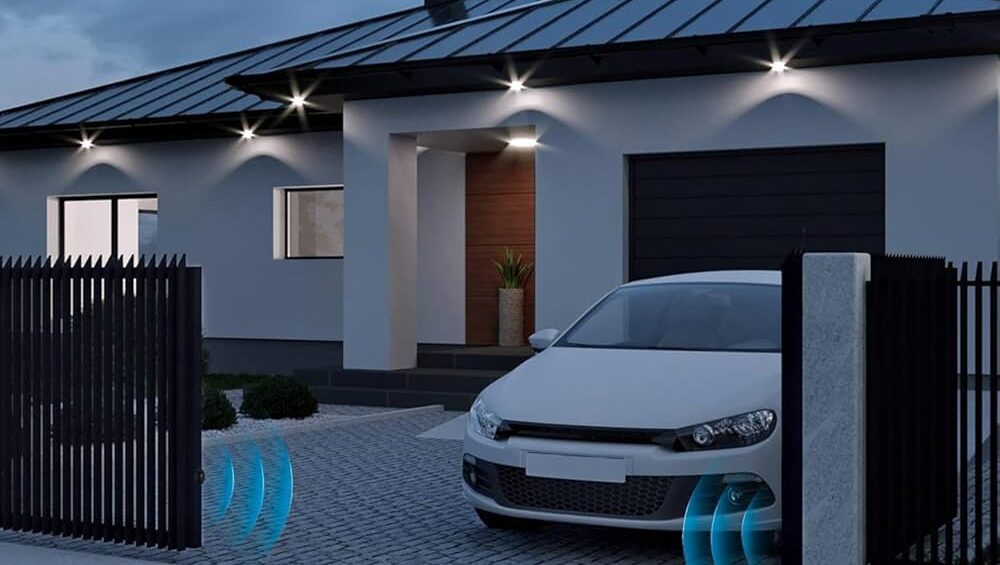Garage door sensors are critical components of modern garage door systems, providing safety, security, and convenience. These sensors help prevent accidents, enhance security, and ensure the smooth operation of garage doors. There are various types of garage door sensors, each serving a unique function. This article delves into the different types of garage door sensors, their functions, and how they contribute to the overall safety and efficiency of garage door systems. Here’s a detailed look at the different types of sensors commonly used in garage doors:
How does a garage door sensor system function?
A garage door sensor system is designed to ensure the safe and proper operation of a garage door. Here’s an overview of how it functions:
Components
- Infrared Sensors: Typically installed on either side of the garage door, about six inches off the ground.
- Control Unit: The main system that processes signals from the sensors and controls the door opener.
- Garage Door Opener: The motorized unit that opens and closes the door, often mounted on the ceiling.
- Safety Reversal System: A feature integrated into the opener that reverses the door if an obstruction is detected.
Functioning
- Alignment of Infrared Sensors:
- The sensors send a beam of infrared light across the width of the door.
- If the beam is uninterrupted, the door can close normally.
- Obstacle Detection:
- If something (like a person, pet, or object) breaks the beam while the door is closing, the sensors detect this interruption.
- The sensor sends a signal to the control unit, triggering the safety reversal system.
- Safety Reversal System:
- Upon receiving the signal, the control unit stops the door from closing.
- The door then reverses direction, opening back up to prevent injury or damage.
- Opening and Closing Cycles:
- When the garage door opener is activated (via remote control, wall switch, or smartphone app), the control unit receives the signal to open or close the door.
- If the door is closing, the sensors continuously monitor for obstructions. If none are detected, the door closes completely.
- If the door is opening, the sensors are generally not active because the door moving upwards does not pose the same risk.
What Kind of Sensor is Used in a Garage Door?
1. Photoelectric (Infrared) Sensors

Overview
Photoelectric sensors, also known as infrared sensors, are the most common type of garage door sensor. They are primarily used for safety purposes, preventing the garage door from closing if an obstruction is detected.
How They Work
Photoelectric sensors consist of two components: a transmitter and a receiver. The transmitter emits an invisible infrared beam across the opening of the garage door to the receiver on the opposite side. If the beam is interrupted by an object, person, or pet, the receiver signals the garage door opener to stop and reverse the door’s movement.
Advantages
- Safety: They prevent accidents by stopping the door if an obstruction is detected.
- Reliability: They are highly reliable and effective in various weather conditions.
- Ease of Installation: They are relatively easy to install and align.
Maintenance
Regular cleaning of the sensor lenses, ensuring proper alignment, and checking the wiring are essential maintenance tasks for photoelectric sensors.
2. Pressure Sensors
Overview
Pressure sensors, also known as contact sensors, are another type of safety sensor used in garage doors. They detect physical contact with an object or person in the door’s path.
How They Work
Pressure sensors are typically installed at the bottom edge of the garage door. When the door closes and comes into contact with an object or person, the sensor detects the pressure and signals the door opener to stop and reverse.
Advantages
- Direct Detection: They provide direct detection of physical obstructions.
- Enhanced Safety: They are an additional layer of safety, complementing photoelectric sensors.
Maintenance
Regularly check for wear and tear on the sensor strip and ensure the connection to the garage door opener is secure. Replace the sensor if it shows signs of damage or malfunction.
3. Motion Detection Sensors

Overview
Motion detection sensors are used to enhance the convenience and security of garage door systems. They detect movement within a specified range and can trigger the opening or closing of the garage door.
How They Work
These sensors use technologies such as passive infrared (PIR) or microwave radar to detect motion. When movement is detected within the sensor’s range, it sends a signal to the garage door opener to activate the door.
Advantages
- Convenience: They allow for hands-free operation of the garage door.
- Security: They can deter unauthorized access by detecting unexpected movement.
Maintenance
Ensure the sensor’s field of view is unobstructed, and periodically test the sensor to confirm it is functioning correctly. Clean the sensor lens regularly to maintain optimal performance.
4. CO2 and Heat Sensors

Overview
CO2 and heat sensors are specialized sensors used primarily in commercial garage door systems. They detect changes in carbon dioxide levels and temperature, which can indicate the presence of vehicles or machinery.
How They Work
These sensors monitor the levels of carbon dioxide and temperature within the garage. An increase in CO2 levels or a rise in temperature can signal the presence of a running vehicle or equipment, prompting the garage door to open or a ventilation system to activate.
Advantages
- Environmental Control: They help maintain air quality and temperature control within the garage.
- Safety: They prevent buildup of harmful gases and overheating.
Maintenance
Regular calibration of the sensors and ensuring they are free from obstructions and contaminants are crucial for their accurate functioning.
5. Smart Sensors
Overview
Smart sensors are the latest innovation in garage door technology, integrating with home automation systems for enhanced control and monitoring.
How They Work
Smart sensors connect to the internet and can be controlled via a smartphone app or a home automation system. They provide real-time notifications and allow for remote operation of the garage door.
Advantages
- Remote Access: They offer the convenience of controlling the garage door from anywhere.
- Enhanced Monitoring: They provide alerts and notifications about the status of the garage door.
Maintenance
Ensure the sensor firmware is up to date and that it is connected to a reliable Wi-Fi network. Regularly check the app for any updates or alerts regarding the sensor’s status.
6. Ultrasonic Sensors
Overview
Ultrasonic sensors are used in advanced garage door systems to detect objects and movement using sound waves.
How They Work
These sensors emit ultrasonic sound waves that bounce off objects and return to the sensor. By measuring the time it takes for the sound waves to return, the sensor can determine the distance to the object and detect any obstructions.
Advantages
- High Precision: They offer precise detection of objects and movement.
- Versatility: They can be used in various applications, including vehicle detection.
Maintenance
Keep the sensor clean and free from obstructions. Regularly test the sensor to ensure it is accurately detecting objects and movement.
Comparison of Different Types of Sensors
Each type of garage door sensor has its unique features and advantages. Here is a comparison to help understand their specific applications:
| Sensor Type | Primary Function | Advantages | Ideal For |
|---|---|---|---|
| Photoelectric Sensors | Safety | High reliability, ease of installation | Residential and commercial use |
| Pressure Sensors | Safety | Direct detection of obstructions | Residential and commercial use |
| Motion Detection | Convenience, Security | Hands-free operation, enhanced security | Residential and commercial use |
| CO2 and Heat Sensors | Environmental Control, Safety | Air quality maintenance, temperature control | Commercial use |
| Smart Sensors | Control, Monitoring | Remote access, real-time notifications | Residential use |
| Ultrasonic Sensors | Object and Movement Detection | High precision, versatile applications | Advanced garage systems |
Installation Tips for Garage Door Sensors
Proper installation of garage door sensors is crucial for their optimal performance. Here are some general tips:
- Follow Manufacturer Instructions: Always adhere to the manufacturer’s guidelines for installation.
- Correct Placement: Ensure sensors are placed at the appropriate height and location as specified.
- Secure Wiring: Properly secure and protect the wiring to prevent damage.
- Regular Testing: Test the sensors after installation to ensure they are functioning correctly.
- Professional Help: If unsure about the installation process, seek professional assistance to avoid any safety risks.
Maintenance Tips for Garage Door Sensors
Regular maintenance of garage door sensors ensures their longevity and reliability. Here are some maintenance tips:
- Cleaning: Regularly clean the sensor lenses and housings to remove dust and debris.
- Alignment Checks: Ensure sensors remain properly aligned to avoid malfunctions.
- Wiring Inspection: Check for any signs of wear or damage to the wiring.
- Functional Testing: Periodically test the sensors to confirm they are working as expected.
- Software Updates: For smart sensors, ensure firmware and software are up to date.
Troubleshooting Common Sensor Issues
Despite regular maintenance, garage door sensors can encounter issues. Here are some common problems and solutions:
- Sensor Misalignment: Realign the sensors to ensure they are properly facing each other.
- Obstructed Sensors: Remove any objects blocking the sensor’s path.
- Damaged Wiring: Inspect and repair any damaged wires.
- Sensor Malfunction: Test the sensor and replace it if it is not functioning correctly.
- Interference: Ensure there are no external factors causing interference with the sensor signals.
Conclusion
Garage door sensors are essential components that enhance the safety, security, and convenience of garage door systems. Understanding the different types of sensors—photoelectric, pressure, motion detection, CO2 and heat, smart, and ultrasonic sensors—allows homeowners and business owners to choose the best options for their needs. Proper installation, regular maintenance, and timely troubleshooting are key to ensuring these sensors function effectively, providing peace of mind and reliable performance for years to come.
Read more: Garage Gate Motors: The Backbone of Modern Garage Door Systems






